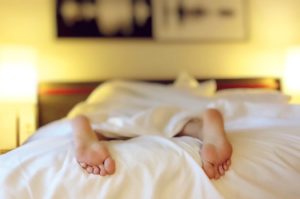 When we ask students at Green Ivy what they’d like more time for in their daily routines, their number one answer is more sleep. Many students are accustomed to a sleep-deprived existence and will quickly point out that the bulk of their friends are getting even less sleep than they are. This situation has become commonplace, with studies showing that nearly 90% of teenagers are sleep-deprived, in part due to mismanaged homework time and late night cramming, excessive use of electronics and the need to be online all the time (a.k.a. FOMO). Most tweens and teens don’t realize that lack of sleep affects all aspects of their lives, from moods to critical thinking skills, so educating students about how to establish good sleep hygiene is one of our top priorities. In particular, we help them understand how blue light—the light emitted from electronics—interrupts regular circadian rhythms by curbing production of the hormone melatonin, which ultimately disrupts sleep.
When we ask students at Green Ivy what they’d like more time for in their daily routines, their number one answer is more sleep. Many students are accustomed to a sleep-deprived existence and will quickly point out that the bulk of their friends are getting even less sleep than they are. This situation has become commonplace, with studies showing that nearly 90% of teenagers are sleep-deprived, in part due to mismanaged homework time and late night cramming, excessive use of electronics and the need to be online all the time (a.k.a. FOMO). Most tweens and teens don’t realize that lack of sleep affects all aspects of their lives, from moods to critical thinking skills, so educating students about how to establish good sleep hygiene is one of our top priorities. In particular, we help them understand how blue light—the light emitted from electronics—interrupts regular circadian rhythms by curbing production of the hormone melatonin, which ultimately disrupts sleep.

Here are some effective ways of promoting a healthier sleep environment in your household:
Grayscale smartphones. Our emotions and attention are tied to perception, and a smartphone’s colorful display takes advantage of that fact. Grayscaling a phone’s display (turning it to black and white) makes the screen less appealing and, therefore, less addicting. Grayscaling can be turned on through a smartphone’s accessibility settings. Grayscaling may not be available on older models of phones (check to see if it is an option, or look for it when upgrading!). Using this strategy on a regular basis can help decrease the compulsive need to constantly check our phones—day and night.
Have your children do homework at the dining room table or in the living room instead of their bedrooms. This strategy may seem unrelated to getting a good night’s sleep, but using bedrooms primarily as a place of rest can help students focus on their work more effectively when needed and encourages relaxation and quality sleep when appropriate.
 Shut down all electronics at least 30 minutes before bedtime (adults and children alike). Doing this allows our bodies to adjust from the impact on melatonin production caused by blue light emissions, and helps us stay on our organic sleep/wake cycle.
Shut down all electronics at least 30 minutes before bedtime (adults and children alike). Doing this allows our bodies to adjust from the impact on melatonin production caused by blue light emissions, and helps us stay on our organic sleep/wake cycle.
Establish an “electronics curfew” for your kids at a certain time each night. About 72 percent of children ages six to 17 sleep with at least one electronic device in their bedroom, which ultimately leads to less sleep. Removing all electronics at a given time means minimizing distractions overall and fewer sleep interruptions in particular. If your child uses his or her phone as an alarm clock, providing an old-fashioned digital one can work wonders!
